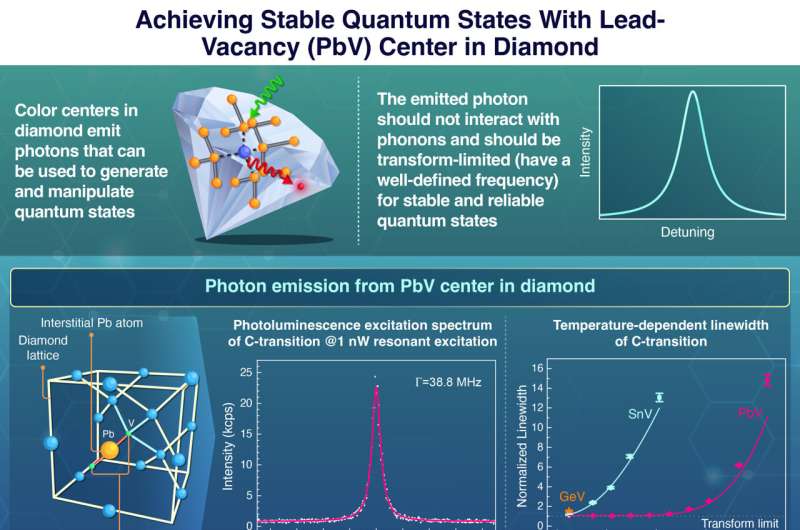Transformation-limited photon emission and high-temperature operation make PbV centers suitable building blocks for scalable quantum networks.Image source: Tokyo Institute of Technology
Just like how circuits use components to control electronic signals, quantum networks rely on special components and nodes to transmit quantum information between different points, forming the basis for building quantum systems.
In the case of quantum networks, color centers in diamonds are defects intentionally added to the diamond crystal and are critical for generating and maintaining stable quantum states over long distances.
When stimulated by external light, these color centers in the diamond emit photons, carrying information about its internal electronic states, especially its spin state. The interaction between the emitted photon and the spin state of the color center allows quantum information to be transmitted between different nodes in the quantum network.
A well-known example of a diamond color center is a nitrogen vacancy (NV) center, where a nitrogen atom is added near a missing carbon atom in the diamond lattice. However, photons emitted from NV color centers do not have a well-defined frequency and are affected by interactions with the surrounding environment, making it challenging to maintain a stable quantum system.
To address this problem, an international team of researchers including Takayuki Iwasaki, associate professor at Tokyo Institute of Technology, developed single negatively charged lead vacancy (PbV) centers in diamond, in which lead atoms are inserted between adjacent vacancies in the diamond crystal.
In a study published in the journal Physical Review Letters On February 15, 2024, researchers revealed that the PbV center emits photons of a specific frequency that are not affected by the vibration energy of the crystal. These properties make photons a reliable carrier of quantum information in large-scale quantum networks.
For a stable and coherent quantum state, the emitted photon must be transformation limited, which means its frequency range should be as small as possible. Furthermore, it should emit to the zero phonon line (ZPL), which means that the energy associated with the photon emission is used only to change the electronic configuration of the quantum system, rather than being exchanged with vibrating lattice modes (phonons) in the lattice.
To create the PbV centers, the researchers introduced lead ions beneath the diamond’s surface through ion implantation. An annealing process is then performed to repair any damage caused by the lead ion implantation. The resulting PbV center exhibits a spin 1/2 system with four different energy states, with the ground state and excited state divided into two energy levels.
When light excites a PbV center, electronic transitions between energy levels produce four different ZPLs, which the researchers classify as A, B, C, and D based on the decreasing energy of the associated transitions. Among them, the C transition was found to have a transformation-limited linewidth of 36 MHz.
“We studied the optical properties of a single PbV center under resonant excitation and demonstrated that the C transition (one of the ZPLs) reaches close to the transformation limit at 6.2 K without significant phonon-induced relaxation and spectral diffusion,” said Dr. Iwasaki.
The PbV center is distinguished by its ability to maintain its linewidth at approximately 1.2 times the transformation limit at temperatures up to 16 K. In comparison, color centers such as SiV, GeV and SnV need to be cooled to much lower temperatures (4 K to 6 K) under similar conditions.
By producing well-defined photons at relatively high temperatures compared to other color centers, PbV centers can serve as efficient quantum light-matter interfaces, enabling photons to transmit quantum information over long distances through optical fibers.
“These results can pave the way for PbV centers to become the cornerstone of establishing large-scale quantum networks,” Dr. Iwasaki concluded.
More information:
Peng Wang et al., Transformation-limited photon emission from lead vacancy centers in diamond above 10 K, Physical Review Letters (2024). DOI: 10.1103/PhysRevLett.132.073601.exist arXiv:DOI:10.48550/arxiv.2308.00995
Provided by Tokyo Institute of Technology
citation: Lead vacancy centers in diamond as building blocks for large-scale quantum networks (2024, April 24) Retrieved April 25, 2024, from https://phys.org/news/2024-04-vacancy- centers-diamond-blocks-large .html
This document is protected by copyright. No part may be reproduced without written permission except in the interests of fair dealing for private study or research purposes. Content is for reference only.
#Lead #vacancy #centers #diamond #serve #building #blocks #largescale #quantum #networks
Image Source : phys.org
